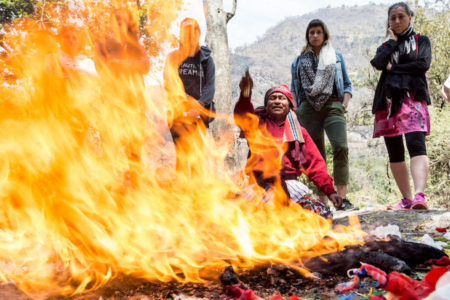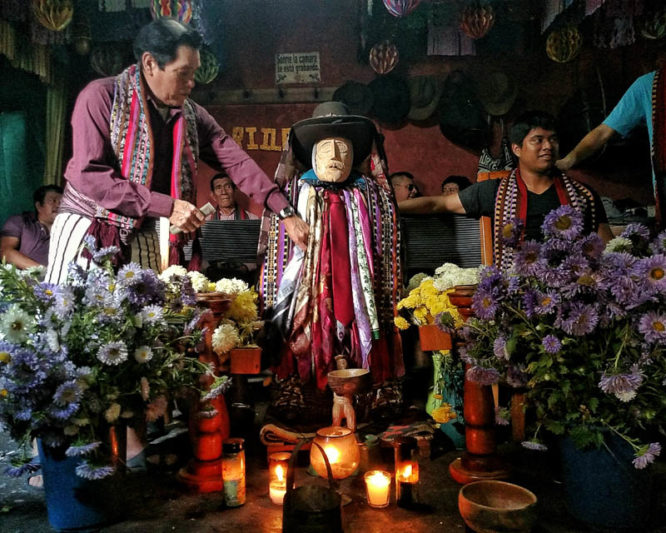 The Cofradias and Traditionalist ways of Santiago are quite “open” and receptive to outsiders and visitors. However, if you decide to visit Maximon, there a few things you must be aware of in order to make your visit a proper one.
The Cofradias and Traditionalist ways of Santiago are quite “open” and receptive to outsiders and visitors. However, if you decide to visit Maximon, there a few things you must be aware of in order to make your visit a proper one.
Historically, the Cofradias moved almost every year. Today there are those that have been in one location for many years, and yet others that move each year or every two years.
Our beloved Grandfather, Maximon does move each year. And since we don’t really have street names in Santiago, your best bet is to get in a tuk tuk, the small red mototaxis that zip around everywhere, and just say “Maximon.” They will lead you to where he now lives, having just moved the first part of May, as he does in great ceremony and procession. Down the alleyway and into the uneven courtyard you will go.
Finding a Guide
If you want to visit Maximon, participate in a ceremony, or simply learn more, you’ll need to have a local guide. Having a guide and “intermediary” to both introduce you and walk you through the customs, is best.
In addition to this, many of the Traditionalist Maya you will encounter in the Ceremonial houses don’t speak a lot of Spanish. Their primary language is Tzu’tujil. So, often when folks come and try to engage and ask questions, they get little or limited response. This usually isn’t a dismissal, as is sometimes felt. It’s just a language barrier.
There are many guides here. And many guys who drive Tuk Tuk’s will offer to guide you and talk to you about Grandfather. These are all options. If you want a fuller experience and explanation there are a few guides I recommend. All of whom have been members of the Cofradias themselves and are themselves Traditionalist. So, they give you the lived in experience, where others offer you more of and about insight.
Dolores Ratzan, who is a member of the Cofradia Santa Cruz where Maximon lives and speaks English (5730-4570). Miguel Pablo Sicay who speaks very good Spanish and a little bit of English (3257-0407). And last but not least – myself, known here as Iliana (4053-8006).
All of us have years of experience and are very happy to share with you. Please contact each of us directly for pricing and availability. Note: a general tour will be priced differently than if you want to come and do ceremony. If ritual is your goal, it is best to call in advance as there is time needed to arrange shamans, purchase materials, etc. The cost will depend on the size of your group and what kind of ritual and offering you want to make. Transportation here in town can also be arranged if needed. So, a heads up is that each part of this will be priced separately.
Entering a Cofradia
When you enter a Cofradia it is custom to make an offering. It’s kind of like church. It’s tithing to the sacred which you have come to meet. If you come as a “tourist” to visit Maximon, you will be charged by the picture…. It’s modern meets ancient. And your experience will be just that – that of a tourist – which is fine, but there are other options.
If you want to have a richer experience – yet don’t want to do a full blown ritual – here’s what I recommend: Purchase a couple of veladoras (glass pillar candles) and a pack of cigarettes (depending on how many of you are in your group).
When you arrive at the Ceremonial House, just sit for a bit and talk, feel, and learn all the wonderful things that live here. Then make an offering to Rilaj Mam of your candles and cigarettes, and buy a Quetzalteca (10Q). Your guide will help guide you through this.
Then you can kneel with the Telinel, head shaman, or another of the other members there who will receive your offerings. When you have had your petitions made, you then make a financial tithing. The money that is given is then used to buy the candles, pay for the marimbas, food, and all the massively intricate needs of the Ceremonial House to carry out the countless fiestas, daily expenses, and Traditions they do in honor of Grandfather. This is true in all of the 13 Cofradias and Ceremonial Houses.
An easy way to understand this is that you offer first before asking a blessing or making a petition. You feed life with gratitude so that life feeds you back. That’s the cycle and groove of the sacred here. Give first. Ask what you desire with your own heart and truth second. Then give gratitude again. You can’t screw up ritual if your heart’s open and you’re just present. That’s the good news. It’s a human thing we all know.

The Offerings
How much you offer is really a personal choice. It’s always tough for us to say because it’s your gifting. Larger groups may make a group offering and for smaller groups, each individual. Again, your guide will guide you. For this, however, Q50-Q100 would be your minimum.
When you’ve completed this, you then buy liters of Coke or Gallo beer to share with all that are present. This is community sharing and done because we as humans, living here on the body of Mother Earth, can receive this on behalf of the ancestors and other wise ones who now live in the spirit world. We do this as their grandchildren, their seeded replacements who live here now.
The members will then serve all that are present. FYI, your guide will help you, but tradition is to buy enough for everyone there. A litre will serve about 5 folks. Gallos are 20q and Coke around 7q. Before you sip or chug, give thanks to all present. In Tzu’tujl you say,”Maltioox Abaj” (mal-tee-osh ah-bah’), gracias in Spanish, Saludos if you prefer, or just, thanks. We always give gratitude before receiving. However you choose to do it, no worries on your pronunciation, it’s the spirit of it that counts.
The Duration Of Your Visit
As to how much time you should plan to spend, it’s truly hard to say. We never know how many people will already be there, if there will be a Shaman already doing ceremony, or how long your blessing will last. And things here NEVER move fast. Patience is your friend in all parts of Guatemala and especially here. At minimum it’s good to plan on a couple of hours in the Cofradia for a full experience. The sitting and sharing in community is part of the Tradition and a good groove to get into as you check out of the hustle and bustle of that hurried linear time of the Modern world.
Attire and Attitude
A final “PS.” from one Westerner to another: To all who come visit this wonderfully wild, vibrant, and sacred place, please remember this is a Mayan community. Dress and attitudes of respect matter a bunch.
First for dress, the three B’s: no buns, boobies or bellies. Yes, this applies to men and women alike. What we consider daily fashion can be an unintended disrespect to traditional ways. These are grandmothers and grandfathers and we are visitors. We also often don’t understand the power of the influence we have on the youth. What they see us do has a big impact on their norms and what is seen as acceptable and popular. So, just keep the sexy clothing, shirtless tops, exposed armpits, and low rider pants to the most minimum. Second, beachwear, short shorts, skin tight clothes, scrubby worn out wear with flip flops, etc. are a pretty please just don’t. Third, hats off when entering the church and Cofradias.
And finally, it’s a common cultural perception that foreigners drink a lot and talk loudly and are invasive. Many come in vacation mode, which is great, but please remember that drinking beer in the streets and talking in loud voices like it’s Spring Break are better reserved for the many other fun places that cater to this. Alcoholism is a huge issue here already. So, it’s best practice to present our selves with good old respect. Remember to smile, listen, ask polite questions, take the time to hang out, and keep your heart open. This will wash away any divisions of culture and language. It all just helps ensure you’ll have a wonderfully rich and sacred time here.
Conclusion
So, if you come over to know Grandfather, or visit any of the other Cofradias, we want you to have an idea of the various ways you can do this. You can do the same in all the Ceremonial Houses and might also choose to visit two or three while you’re here. While the above does get pricier than the standard tuk tuk driver and a quick visit, it’s a wonderful experience to really participate and share in what lives here. A full ritual and blessing is yet another process. We’ll probably share more on that in a future article.
I hope you’ll come visit, explore, and share in all that lives here in our sacred ceremonial houses sometime soon.
To learn more about the history of Mayan tradition in Santiago, click here.
